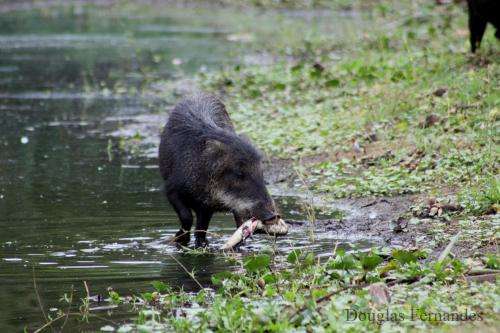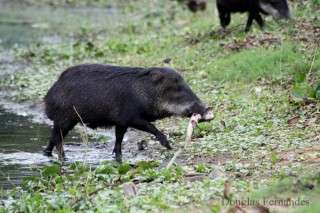Sushi for peccaries?

It turns out the white-lipped peccary—a piglike animal from Central and South America—will settle for fish when fruits (its main food) are no longer on the menu, according to the Wildlife Conservation Society and partners revealing the first-ever photos of fish-eating peccaries.
The images of fish consumption by white-lipped peccaries were taken by Douglas Fernandes in the Brazilian Pantanal wetlands one morning back in 2011. A short description of the observations, along with the digital photographs taken, will appear in the latest edition of Suiform Soundings (IUCN Peccary Specialist Group Newsletter).
"As far as we know, these are the first images of fish consumption by white-lipped peccaries," said Dr. Alexine Keuroghlian of the Wildlife Conservation Society and an expert on peccaries. "This finding expands our knowledge of how this ecologically important species survives in highly seasonal habitats."
While there was one reported account by Dr. Joe Fragoso of the white-lipped peccary dining on fish in the Amazon, the behavior has been rarely seen and apparently never photographed until the morning of August 17, 2011. On that day, Fernandes, a researcher for the Instituto Arara Azul, a partner organization , observed a group of approximately 30 white-lipped peccaries at Caiman Lodge near the town of Miranda in the Pantanal, one of the world's largest tropical wetlands. Most of the peccaries fled as he approached, but five remained as they fed on aquatic plants in shallow ponds, created by the receding flood waters typical of the Pantanal's dry season. It was then that Fernandes noticed three of the peccaries eating traira, or wolf fish, from the oxygen-starved ponds.

"We know that peccaries are primarily fruit-eaters, but will consume aquatic plants, tubers, grasses, and small invertebrates, such as insect larvae, worms, and snails, when fruits are scarce," said Dr. Keuroghlian.
"At the time, I knew this was a rare observation but was unaware of the fact that I was taking perhaps the first images of this behavior," said Fernandes.
The white-lipped peccary is a medium-sized animal that occurs in both humid tropical forests as well as open savanna and wetland habitats throughout Central and South America. The species sometimes travels in herds of hundreds of individual animals, the only Neotropical ungulate (hoofed mammal) known to do so. As a major fruit-eater, the white-lipped peccary plays an important ecological role in rainforests and other habitats as a seed predator and disperser, and it is a favorite prey of jaguars and pumas. Additionally, white-lipped peccaries are considered an environmental indicator of a well-preserved forest.
The white-lipped peccary is listed as "Near Threatened"on the IUCN's Red List, but its status is currently under review as "Vulnerable." The two main threats faced by white-lipped peccaries are habitat loss and direct hunting.
Provided by Wildlife Conservation Society


















